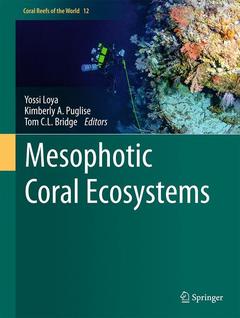Mesophotic Coral Ecosystems, 1st ed. 2019 Coral Reefs of the World Series, Vol. 12

This book summarizes what is known about mesophotic coral ecosystems (MCEs) geographically and by major taxa. MCEs are characterized by light-dependent corals and associated communities typically found at depths ranging from 30-40 m. and extending to over 150 m. in tropical and subtropical ecosystems. They are populated with organisms typically associated with shallow coral reefs, such as macroalgae, corals, sponges, and fishes, as well as specialist species unique to mesophotic depths. During the past decade, there has been an increasing scientific and management interest in MCEs expressed by the exponential increase in the number of publications studying this unique environment. Despite their close proximity to well-studied shallow reefs, and the growing evidence of their importance, our scientific knowledge of MCEs is still in its early stages. The topics covered in the book include: regional variation in MCEs; similarities and differences between mesophotic and shallow reef taxa, biotic and abiotic conditions, biodiversity, ecology, geomorphology, and geology; potential connectivity between MCEs and shallow reefs; MCE disturbances, conservation, and management challenges; and new technologies, key research questions/knowledge gaps, priorities, and future directions in MCE research.
1. Mesophotic coral ecosystems: Introduction and Overview
Part II: Regional Variation in Mesophotic Corarl Ecosystems
2. Bermuda
3. The Bahamas and Cayman Islands
4. Pulley Ridge, Gulf of Mexico, U.S.A.
5. The Mesoamerican Reef
6. Discovery Bay, Jamaica
7. Puerto Rico
8. The United States Virgin Islands
9. Bonaire and Curaçao
10. Brazil
11. The Red Sea
12. The Chagos Archipelago
13. Ryukyus Islands, Japan
14. Taiwan
15. The Philippines
16. Palau
17. Pohnpei, Federated States of Micronesia
18. Papua New Guinea
19. North West Australia20. The Great Barrier Reef and Coral Sea
21. Fiji
22. American Samoa
23. Cook Islands
24. French Polynesia
25. The Hawaiian Archipelago
26. Isla del Coco, Costa Rica, Eastern Tropical Pacific
27. Chile and Salas y Gómez Ridge
Part III: Environments, Biodiversity, and Ecology of Mesophotic Coral Ecosystems
28. The mesophotic coral microbial biosphere
29. Macroalgae
30. Symbiodinium genetic diversity and symbiosis with hosts from shallow to mesophotic coral ecosystems
31. Large benthic foraminifera in low-light environments
32. Sponges
33. Biodiversity of reef‐building, scleractinian corals
34. Reef‐building corals of the upper mesophotic zone of the central Indo‐west
Pacific
35. Sexual reproduction of scleractinian corals in mesophotic coral ecosystems
vs. shallow reefs
36. Coral sclerochronology: similarities and differences in the coral isotopic
signatures between mesophotic and shallow reefs
37. Antipatharians of the mesophotic zone: four case studies
38. Octocorals of the Indo‐Pacific
39. Gorgonian corals
40. Fishes: Biodiversity
41. Disease problems
42. Light, temperature, photosynthesis, heterotrophy, and the lower depth
limits of mesophotic coral ecosystems
43. Bioerosion
44. Geology and geomorphologyPart IV: Are Shallow and Mesophotic Coral Ecosystems Connected?
45. Beyond the ‘deep reef refuge’ hypothesis: a conceptual framework to
characterize persistence at depth
46. Coral ecosystem connectivity between Pulley Ridge and the Florida Keys
Part V: Conservation, Management, and Threats to Mesophotic Coral Ecosystems
47. Disturbance in mesophotic coral ecosystems nd linkages to conservation and management
48. Invasive lionfish (Pterois volitans and P. miles ): distribution, impact, and
Management
49. Ecosystem Services of mesophotic coral reefs and a call for better accounting
Part VI: Mesophotic Coral Ecosystems Research: Technologies and Future Directions
50. Advanced Technical Diving
51. Underwater robotic technology for imaging mesophotic coral ecosystems
52. Key questions for research and conservation of mesophotic coral ecosystems and temperate mesophotic ecosystems
Primary source for a basic understanding of Mesophotic coral ecosystems (MCEs)
First reviews of major mesophotic taxa
Looks into MCE’s geographical variations, similarities, differences between MCE’s and potential connectivity between MCEs and shallow reefs
Covers the conservation, management and threats to MCEs and future research directions
Date de parution : 06-2019
Ouvrage de 1003 p.
21x27.9 cm
Thèmes de Mesophotic Coral Ecosystems :
Mots-clés :
Mesophotic coral ecosystems; Shallow coral reefs; Invasive lionfish; Coral reef conservation; Coral reef management; Ecosystem services; Coral diseases; The Coral Triangle; Scleractinian corals; Sclerochronology; Antipatharians; Octocorals; Gorgonians; marine and freshwater sciences; climate change



